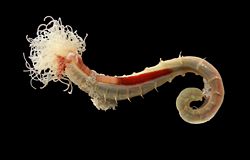| Sedentaria | |
|---|---|
| Examples of Sedentaria (clockwise from upper left corner): Sabellida, Echiura, Maldanomorpha, Clitellata, Terebelliformia, Siboglinidae. | |
| Scientific classification | |
| Kingdom: | Animalia |
| Phylum: | Annelida |
| Clade: | Pleistoannelida |
| Clade: | Sedentaria Lamarck 1818 |
| Orders and families | |
Incertae sedis | |
Sedentaria is a diverse clade of annelid worms. It is traditionally treated as a subclass of the paraphyletic class Polychaeta, but it is also a monophyletic group uniting several polychaetes and the monophyletic class Clitellata. It is the sister group of Errantia. [1]
Sedentaria are mainly found within marine environments that have low oxygen levels and are specially adapted to these low oxygen environments by increasing gill surface area and having high-affinity respiratory proteins. Furthermore, they go through a process of metabolic depression which lowers their energy use so that they can inhibit these low oxygen zones. [2]





